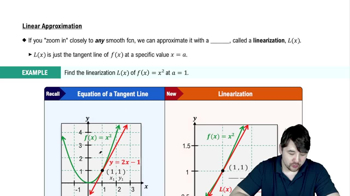If ƒ is an odd function, why is ∫ᵃ₋ₐ ƒ(𝓍) d𝓍 = 0?
Table of contents
- 0. Functions7h 54m
- Introduction to Functions16m
- Piecewise Functions10m
- Properties of Functions9m
- Common Functions1h 8m
- Transformations5m
- Combining Functions27m
- Exponent rules32m
- Exponential Functions28m
- Logarithmic Functions24m
- Properties of Logarithms36m
- Exponential & Logarithmic Equations35m
- Introduction to Trigonometric Functions38m
- Graphs of Trigonometric Functions44m
- Trigonometric Identities47m
- Inverse Trigonometric Functions48m
- 1. Limits and Continuity2h 2m
- 2. Intro to Derivatives1h 33m
- 3. Techniques of Differentiation3h 18m
- 4. Applications of Derivatives2h 38m
- 5. Graphical Applications of Derivatives6h 2m
- 6. Derivatives of Inverse, Exponential, & Logarithmic Functions2h 37m
- 7. Antiderivatives & Indefinite Integrals1h 26m
- 8. Definite Integrals4h 44m
- 9. Graphical Applications of Integrals2h 27m
- 10. Physics Applications of Integrals 3h 16m
- 11. Integrals of Inverse, Exponential, & Logarithmic Functions2h 34m
- 12. Techniques of Integration7h 41m
- 13. Intro to Differential Equations2h 55m
- 14. Sequences & Series5h 36m
- 15. Power Series2h 19m
- 16. Parametric Equations & Polar Coordinates7h 58m
8. Definite Integrals
Average Value of a Function
Problem 5.4.45c
Textbook Question
Explain why or why not Determine whether the following statements are true and give an explanation or counterexample.
(c) The average value of a linear function on an interval [a, b] is the function value at the midpoint of [a, b] .
 Verified step by step guidance
Verified step by step guidance1
Step 1: Recall the formula for the average value of a function f(x) on an interval [a, b]. It is given by: .
Step 2: For a linear function, f(x) = mx + c, substitute this into the formula for the average value. The integral becomes: .
Step 3: Compute the integral of the linear function. The integral of mx is , and the integral of c is cx. Evaluate these terms at the bounds a and b.
Step 4: Simplify the result of the integral and divide by (b - a) to find the average value. After simplification, the average value of the linear function will be: , which is the function value at the midpoint of [a, b].
Step 5: Conclude that the statement is true. The average value of a linear function on an interval [a, b] is indeed equal to the function value at the midpoint of [a, b], as shown by the calculation.
 Verified video answer for a similar problem:
Verified video answer for a similar problem:This video solution was recommended by our tutors as helpful for the problem above
Video duration:
4mPlay a video:
Was this helpful?
Key Concepts
Here are the essential concepts you must grasp in order to answer the question correctly.
Average Value of a Function
The average value of a function f(x) over an interval [a, b] is calculated using the formula (1/(b-a)) * ∫[a to b] f(x) dx. This concept is crucial for understanding how to find the mean value of a function across a specified range, which can differ from simply evaluating the function at a single point.
Recommended video:

Average Value of a Function
Linear Functions
A linear function is a polynomial function of degree one, typically expressed in the form f(x) = mx + b, where m is the slope and b is the y-intercept. The properties of linear functions, such as constant slope and direct proportionality, influence how their average value behaves over an interval.
Recommended video:

Linearization
Midpoint of an Interval
The midpoint of an interval [a, b] is calculated as (a + b)/2. For linear functions, evaluating the function at this midpoint can yield the average value, but this is not true for non-linear functions. Understanding this concept helps clarify why the statement may hold true specifically for linear functions.
Recommended video:

Left, Right, & Midpoint Riemann Sums

 6:37m
6:37mWatch next
Master Average Value of a Function with a bite sized video explanation from Patrick
Start learningRelated Videos
Related Practice
Textbook Question
33
views
